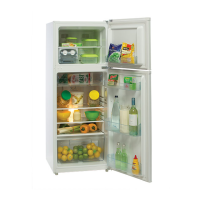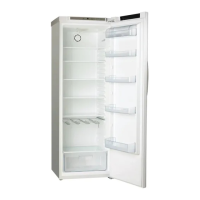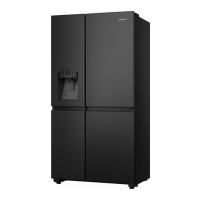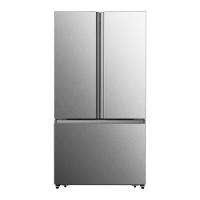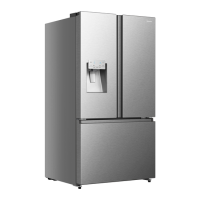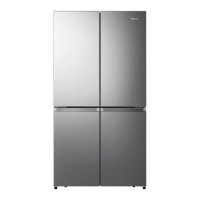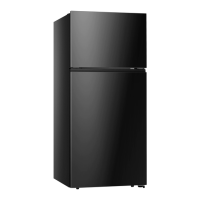
Do you have a question about the Hisense HRT180N6ABD and is the answer not in the manual?
| Brand | Hisense |
|---|---|
| Model | HRT180N6ABD |
| Category | Refrigerator |
| Language | English |
Explains the meaning of warning, danger, and caution alerts.
Details critical electrical safety measures for appliance operation and installation.
Provides general cautions for safe appliance use, including flammables and ventilation.
Provides advice on safe daily operation, food storage, and appliance maintenance.
Outlines measures to ensure the safety of children and infirm persons around the appliance.
Identifies and describes the main components of the refrigerator.
Lists package contents and identifies parts required for reversing the refrigerator door.
Warns about the importance of a level, strong surface for refrigerator installation.
Details the necessity of adequate ventilation around the appliance for heat dissipation.
Recommends specific spacing from walls and other surfaces for proper airflow.
Specifies the ideal ambient temperature range for the refrigerator to function correctly.
Details how to adjust the bottom feet for proper appliance leveling and air circulation.
Explains tilting the appliance slightly for optimal door self-closing.
Lists essential tools required for appliance installation and door reversal procedures.
Emphasizes disconnecting power before attempting to reverse the refrigerator door.
Outlines the general steps involved in reversing the refrigerator door for installation flexibility.
Instructs on removing the upper hinge and detaching the refrigerator doors safely.
Details the process of removing and installing door stopper blocks for reversed door swing.
Provides instructions for moving and re-installing the lower hinge to the opposite side.
Guides on attaching the lower hinge and adjustable feet to the opposite side for door reversal.
Details the process of mounting the refrigerator and freezer doors onto their new hinge positions.
Guides on securing the upper hinge and its cover on the top left side after door reversal.
Explains the process of setting the refrigerator temperature using the control panel buttons.
Details how to activate and deactivate the demo mode for store display purposes.
Explains how to adjust the temperature settings for the freezer compartment.
Offers important advice on temperature settings and the impact of sensor placement.
Advises on proper storage of vegetables, fruits, and other items in the refrigerator.
Details the use and placement of wire shelves and door bins for optimal storage.
Explains how to use and clean the crisper drawer for storing fruits and vegetables.
Provides basic information on using the freezer compartment.
Guides on the operation, notes, and safety precautions for the automatic ice maker.
Advises to disconnect power before cleaning to avoid electrical shock.
Guides on cleaning the exterior surfaces with mild detergents and soft cloths.
Provides methods for cleaning the interior, including defrosting accumulated frost.
Explains how to clean door gaskets and the importance of them being dry.
Details the procedure for safely replacing the LED light inside the appliance.
Provides tips for maximizing energy efficiency and saving electricity.
Guides on best practices for refrigerating fresh food to maintain quality.
Provides advice on freezing food and proper storage of frozen goods.
Details the steps for turning off the appliance for extended periods to prevent issues.
Advises against self-repair and recommends contacting qualified service personnel.
Provides checks and solutions for common issues where the appliance does not work.
Offers guidance on addressing and eliminating odors from the refrigerator and freezer.
Differentiates between normal operating sounds and potential issues causing unusual noises.
Lists conditions that may cause the motor to run continuously, such as temperature settings or ambient heat.
Addresses causes of frost and suggests checks for air outlets and door closure.
Provides solutions for temperature discrepancies, including door usage and clearance.
Offers checks for proper door closure, including tilt angle and obstructions.
Addresses issues with the LED light, including damage or system disabling.
States that the appliance must not be disposed of as household waste due to environmental concerns.
Guides on recycling the packaging materials associated with the appliance.
Details necessary steps, such as unplugging and removing the power cord, before disposal.
Advises removing doors to prevent suffocation hazards for children.
Explains how to correctly dispose of the appliance as electronic waste for environmental protection.



